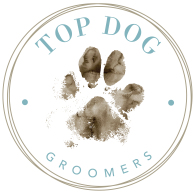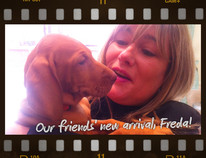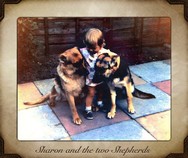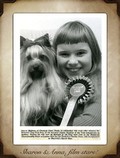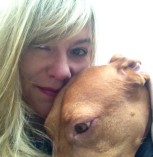Sharon's Blog
Monday 15th July 2013
FOODS TO AVOID FEEDING YOUR PETS.
I've been asked by customers to do this blog and I'm only too happy to oblige. As the owner of a loopy Hungarian Vizsla who will eat anything and everything he shouldn't, I can speak with some
authority on this next blog!
I have researched this subject on the internet so you don’t have to and below you will find a simple list of what to avoid and why. It’s not exhaustive but includes most of the food types
that your dogs are likely to come across; there might even be a few surprises in there too.
Chocolate and Caffeine
Chocolate and Cocoa contain a chemical called theobromide which can adversely affect the internal organs and nervous system of your dog. For example, 2 oz of baking chocolate can poison a 20 lb dog which isn’t a lot if you think about it. Milk chocolate, (as it contains less cocoa) would take more to poison your dog but still isn’t advised. Sign and symptoms are what you would expect from a dog that had been ‘poisoned’ which includes diarrhoea and vomiting.
Caffeine acts very similarly to chocolate and cocoa chemical, theobromide, affecting the internal organs and nervous system of your dog. Signs and symptoms are the same.
Vets may induce vomiting as treatment.
Alcohol
The bottom line is we poison ourselves regularly with booze. We build up a certain tolerance and understand the consequences of ‘over doing it’ and recognise when we’re hung over.
Dogs unfortunately don’t understand any of this so if they’re able to raid your cupboard and drink your booze, they will experience all the effects you would but on a much higher scale due to no tolerance and far less blood.
Can you imagine a raging hangover and not knowing what it was? You will find therefore as well as displaying drunk and physical side effects, (such as vomiting) your dog would also become potentially scared or even aggressive.
It’s the ethanol in your booze that is the poison and inducing vomiting wouldn’t necessarily work here due to the quick digestion so your vet would probably deliver fluid therapy and medication.
Of note, uncooked yeast dough also produces ethanol.
Interestingly, controlled amounts of ethanol are used as treatment for your dog ingesting anti freeze.
Macadamia Nuts
Macadamia Nuts are an odd one as the experts don’t actually know what the poison is and as a result the vet can only treat the symptoms if ingested by your dog. I don’t believe there have been any fatalities related to these nuts but severe illness can be expected. The signs and symptoms can also be as late as 24 hours after ingestion.
Grapes & Raisins
These apparent innocent fruits and cause irreversible kidney damage and even death for your dog. As few
as 4 or 5 can be poisonous to a 20lb dog, making them very dangerous. Like the nuts, symptoms can be delayed as much as 24 hours which are like all the other symptoms of being poisoned. Inducing
vomiting might not be enough here and your vet may pump your dogs stomach.
Bones
Cooked bones will splinter!
Xylitol
Xylitol, (which is used as a sweetener in many products, including gum) when ingested basically causes your dog to go hypoglycaemic as it THINKS it’s getting sugar so produces insulin resulting
in your dogs’ body having a very low blood sugar. Just 2 peices of chewing gum can do this to a 20lb dog. Severe liver damage can be expected too. As well as inducing vomiting, your dog can expect to
be on a sugar (dextrose) drip for up to 2 days at the vets to get their blood sugar back to normal.
Onions, Garlic, Chives
Basically, these vegetables will make your dog become anaemic followed by kidney damage eventually.
The actual quantities aren’t known but the experts believe it can cumulative and includes cooked onions too so NO Sunday dinner scraps! You can see signs of anaemia by checking your dog’s gums: if
they’re pale, then its sure indicator. Your vet would probably do a blood transfusion here followed by fluid therapy.
Milk
Because dogs do not possess significant amounts of lactase (the enzyme that breaks down lactose in milk), milk and other milk-based products can cause them diarrhoea or other digestive
upset.
Monday 1st July 2013
BLOG: SAFE DOG WALKING.
I write a lot of these blogs as and when they come to mind and therefore have several ready at any one time. This one I have brought forward in light of the awful and despicable incident that happened several weeks ago on The Dukes Drive in Chester.
Please note that I don’t believe the following words could have prevented this incident; I wouldn’t presume to be so inappropriate or crass. Please take them for what they are which is an awareness of good practice.
~
Awareness is the most important aspect of staying safe and for self-defence whilst out dog walking. Practice the following regularly:
- Walk strong. confident and with purpose
- Be aware of your surroundings, especially behind you
- Keep your hands free e.g. use a bag for all your dog gear
- Be seen
- Walk towards the traffic; not with it approaching you from behind
- Get an early view when walking around blind corners
- Walk down the middle of the path
- Don’t ‘plug in’ when walking; you can’t hear what’s going on around you.
- If possible, walk with someone you know
- Take your phone
- Change your routine and route regularly
- Stay in populated areas if you can
- Hand alarms, get one.
Don’t avoid walking your dog in the great British outdoors; just be prepared and street smart. Common sense should always prevail when you and your dog are out walking.
Monday 24th June 2013
TEETH BLOG
Hi guys. Here’s my blog on teeth. Hope it’s useful!
Dogs start out with 28 deciduous (baby) teeth. By six months of age, these baby teeth fall out and are replaced by permanent 42 teeth.
If the deciduous teeth don't fall out and the permanent teeth erupt under them, this can lead to problems, such as increased tartar formation, malocclusion problems, and gingival (gum) irritation.
The sooner you start cleaning teeth the better and with the help of your Vet, be on the lookout for retained deciduous teeth and malocclusion (bad bite) problems. Your Vet can teach you how to care for your pet's teeth and gums early on.
Bad breath is often a first indicator of dental disease. Gently lift the lips and check for tartar, inflamed gums, or missing/broken teeth. They can exhibit reluctance to eat or play with toys, "chattering" of the teeth when trying to eat, lethargy, bleeding gums and eroded teeth. Dental disease progresses in stages and if caught early, you can prevent further damage and save as many teeth as possible.
Infected gums and teeth aren't just a problem in the mouth; the heart, kidneys, intestinal tract, and joints may also be infected.
The tartar and any infected areas of the mouth contain a multitude of bacteria that can then affect other parts of the body. With regular dental care, you can prevent some of these more serious side effects.
With a new puppy or kitten, talk to your Vet at the vaccination appointments about how to initiate a good dental care program at home. Most Vets are happy to provide brushing lessons, and many carry brushes and toothpaste specifically for dogs. NEVER use human toothpaste on your pet!
If your pet is an adult over 3 years of age, it would be wise to schedule a dental check up with your Vet. If a dental cleaning is necessary, it is advisable to do pre-aesthetic blood work to make sure your pet does doesn't have any underlying problems.
Pre-aesthetic blood work is a check on the overall health of the pet to make sure that the liver, kidneys and blood counts are within normal ranges and to reduce any risks possible prior to the anaesthesia. Many pets with bad teeth will be put on an antibiotic a few days prior to the dental to calm the infection and reduce possibility of complications.
Your pet will be fasted from the evening before for the anaesthesia. The dental cleaning itself is similar to that of a human; tartar removal, checking for cavities, gingival (gum) pockets, loose teeth, any growths on the gums or palate, removal of diseased teeth and finally, polishing. The polishing is to smooth the tooth after tartar removal, as the tartar pits the tooth. A smooth tooth will not encourage tartar formation as easily as a roughened tooth.
All of that said, I will always have a look as part of my grooming services, whether you're in for a full groom or refresh and if I think there are any obvious signs, I'll let you know. When it comes to their teeth however, I always recommend speaking to your vet too of course.
As always, contact me if you have a question.
With good dental care, your pet can enjoy a long and healthy life.
See you all soon
Sharon X
Wednesday 19th June 2013
HEATSTROKE BLOG.
Right guys, it's that time of year again when the weather is so changeable (which we've all seen lately) and with busy schedules there are days out and sometimes we take our pets as they're part of the family too.
You have to be aware of heatstroke and what to look for and if in the awful event you see an animal trapped in a car, don't hesitate to call 999 who will gain entry and remove the dog. If you're not sure or need any more advice on this, call me.
I pray none of you ever see a dog with heatstroke because if you do witness this it's something you'll remember for the rest of your life!
Knowing this might just save a life.
Hyperthermia (not to be confused with hypothermia) is a term describing an elevation in body temperature. This increase typically occurs as a response to a 'trigger' such as an exposure to prolonged high temperatures.
It occurs with the inflammation in the body or a hot environment (e.g car).
It happens because dogs do not sweat through their skin like humans. They release heat by panting, and they sweat through their foot pads and nose.
If a dog cannot lower their temperature, this is where heatstroke strikes.
Don't be fooled into thinking it won’t happen to your dog! All dogs are at risk! Some dogs are more prone though. For example dogs with short snouts, fatter or heavily muscled dogs and long haired breeds as well. Old and very young dogs too are at risk as well as dogs prone to certain diseases and dogs on certain medication.
Some signs to look for are:
1. Heavy panting,
2. Profuse salivation
3. Rapid pulse
4. Very red tongue or gums,
5. Lethargy
6. Lack of co-ordination
7. Reluctance or inability to rise after collapsing
8. Vomiting
9. Diarrhoea
10. Extreme circumstances loss of consciousness.
If you do find yourself in a position around a dog with heatstroke here are a few tips that could save a life:
1. First of all take your dog into a shaded area.
2. Soak them with COOL water. DO NOT use cold water or iced water as this will cause the blood vessels to constrict and stop heat from escaping.
3. You can then apply ice packs underneath the legs or groin area for rapid blood cooling.
4. Give your dog enough water to wet his mouth and throat but DO NOT allow your dog to drink copious amounts.
5. DO NOT cover your dog with a cold towel as this will prevent the heat from escaping.
6. There is a danger your dog can become too cold. Stay with your dog and visit your vets immediately even if your dog seems to have recovered.
I know this may be asking you to suck eggs as a lot of it is common sense but just reading these words may just help should this happen to your dog or another that you might see in distress.
See you soon.
Sharon X
Thursday 6th June 2013
BARF Diet.
How you feed your dog is purely your own business but after owning a very picky eater (Standard Poodle) who had a lot of medical problems I wish we would have found this way of eating sooner.
I personally wouldn't feed a dog on anything else, ever! Bodie has been fed Natural Instinct since 8 weeks old and he's now 3!
I have copied below information from Natural Instincts website which you can also find on my links.
"Why Your Dog Deserves A BARF (Biologically Appropriate Raw Food) Diet
(this piece was assembled in association with top vet, Nick Thompson)
Despite being a far from ideal acronym, it’s important to understand that BARF isn’t a foolish fad for over-indulgent pet owners. It is however a simple, back-to-basics pet feeding philosophy
that puts your dog first by reminding pet owners that the phrases ‘processed’ and ‘quality’ rarely sit at ease together.
Putting aside the fact that our best friend’s ancestors were happily hunting and scavenging long before phrases like bake, braise, broil or boil had ever been invented, there’s oodles of modern
day evidence to suggest that when it comes to looking after your dog’s health interests, a new way of thinking is long overdue.
Dogs of all ages and breeds love it (a good starting point)
Stools regain their shape and are once again pick-upable!
Vitality and stamina often improves dramatically, even over a short space of time
They smell better (coat, breath and skin) and any adverse skin conditions clear up
Dogs on processed food diets need dental work every 2-3 years
Pets bloom with our food (i.e. exude vitality, whilst their coats retain their glossiness)
Pets on raw food are satisfied after their meal in stark contrast to dogs on a processed diet who get hyperactive and race around the house much like after an unsatisfying ‘junk-food'
fix
More variety in tastes & textures
The sad truth is that dogs are often diagnosed as ill, whereas in reality they’re simply often not eating well. With issues like obesity, diabetes and heart attacks causing more and more of us to
re-evaluate our daily diets and dramatically reduce our processed food intake, it seems foolhardy to impose the same ill-fated quick-fix thinking on our pets!"
Right I'm back! There's no doubt that dogs are carnivores and they love the internal organs too.
Basically, unless your dog has an allergy to certain foods it will survive whatever you decide to feed.
Dry food is convenient, easy to obtain, store and needs little thought or imagination.
But before you decide whether this really is the right food, mix it with water for 10 minutes or so and then see how it looks. We are told this food is completely balanced and there is
no need to feed a dog more than this. However many dogs have an intolerance to wheat products or even worse gluten which is found in wheat, barley, oats and rye.
Any change of food must be gradual over weeks rather than days!
A typical meal plan:
Breakfast: (after exercise) raw meat followed by one or two raw chicken wings.
Lunch: for puppies milk and honey with a little puppy food and scrambled egg
Dinner: mostly raw food, chicken wings
***Cooked bones are dangerous as they can easily splinter***
Raw Bones will provide the natural calcium required.
Natural Instinct takes all the work away as it has everything your dog needs and all you have to do is weight it out and you're ready to go!
If you do decide you want to feed raw yourself some adult dogs (eg Standard Poodles) eat about one pound of meat a day total. Obviously this changes with breed and weight! A puppy
will eat as much, if not more. Puppies must be fed three meals a day at least. If you dog increases its weight too much just cut down the amount not the number of feeds.
Garlic is wonderful for keeping worms and fleas at bay as well as stomach disorders, and brewers yeast for vitamin B.
Two or three times a week give vegetables, dogs also like eggs, cheese, pasta, rice. If you feed raw and add supplements you'll be feeding a balanced diet.
Hope you've enjoyed my blog.
Love,
Sharon ; ) X
Tuesday 28th May 2013
STOLEN PETS.
This is something close to my heart as friends have had their precious family pets stolen. Some have been lucky enough to be reunited; others are still searching.
In my research, many of the dogs that are stolen are working breeds. Trained gundogs are being sold on for thousands of pounds and being taken for breeding.
The current economic climate is being blamed as one reason for the stolen pets as many breeds of puppy can sell for hundreds of pounds.
Some thieves are even demanding ransoms for the dogs’ safe return!!!! The price of many pedigree dogs has rocketed attracting price tags of around £2,500.
A recent story you may or may not be aware of is the story of Angel; the Short Haired Pointer stolen whilst her owner, Dawn, was putting one of her other dogs in her car. She looked around and
Angel had gone! Dawn saw a white transit van driving off. She has remortgaged her South Yorkshire home and put up a £10,000 reward for Angel's safe return. If you're on Facebook or Twitter you will no doubt have seen postings from Dawn. Let's hope Angel is back home safe with the family soon as I know
she is very much missed by all the family.
On a lighter note and a success story from last year was a Staffordshire Bull Terrier which was stolen from a family home in Hartcliffe. 4 years on, the dog was on an advert on FB for sale and
a friend of the family saw this and notified the relevant authorities!!!! Unbelievable but true!!!!
All I can say is, be vigilant when taking your dogs for a walk in your local park because these are the very places these thieves go to. Never leave your dog tied up
outside a shop, even if you are just 'popping' in.
Recently, I’ve even heard of litters being stolen from the home, gardens and even one dog being dragged from owners’ arms so please be very careful and don’t take your dogs’ safety for granted.
Sharon x
Wednesday 15th May 2013
I'm really excited to let you all know that from the end of July I'll be fully qualified to microchip your pets, so if your dog hasn't been micro chipped and you want to get them sorted before 2016 give me a bell and I'll sort it for you!
2016 I hear you ask? Well by April 2016, all dogs will need to be micro chipped. It’s a new Government campaign to help lost pets be reunited with their owner and ultimately reduce stray dog
numbers.
It's only a chip the size of a small grain of rice inserted between the shoulder blades; totally painless but totally priceless if your dog goes missing.
Once I’ve completed the course, I’ll blog about my experiences on the day, any funnies and of course what cost I will be able to offer this service at.
Finally, to all my customers, I am in the process of designing a logo for Top Dog Groomers and the services we offer. You all know me and what I do better than most so if you have any amazing ideas, I’d love to hear from you. You know where I am!
Where to find us:
BESPOKE HOLIDAY BOARDING AND DAYCARE
Testimonials
Hi Sharon.
Missie AKA Popet, came to you for her first groom on Thursday, (she is 9 months old now). I would just like to say you made me feel at ease the minute I spoke to
you.
I new my Missie was in safe hands. You really did an amazing job considering how matty my baby was !!.
Your skills with the scissors was like magic, she is matt free :-) we will be seeing you again for a refresh in a couple of weeks.
Thank you Sharon for making Missie feel safe x Read more...
Sharon would like to say...
What's new?
New!!! Transformation of the week!
Check out Sharon's old photos of her and her family back in the day.
Also, look out for her Pooch Art... no really!

